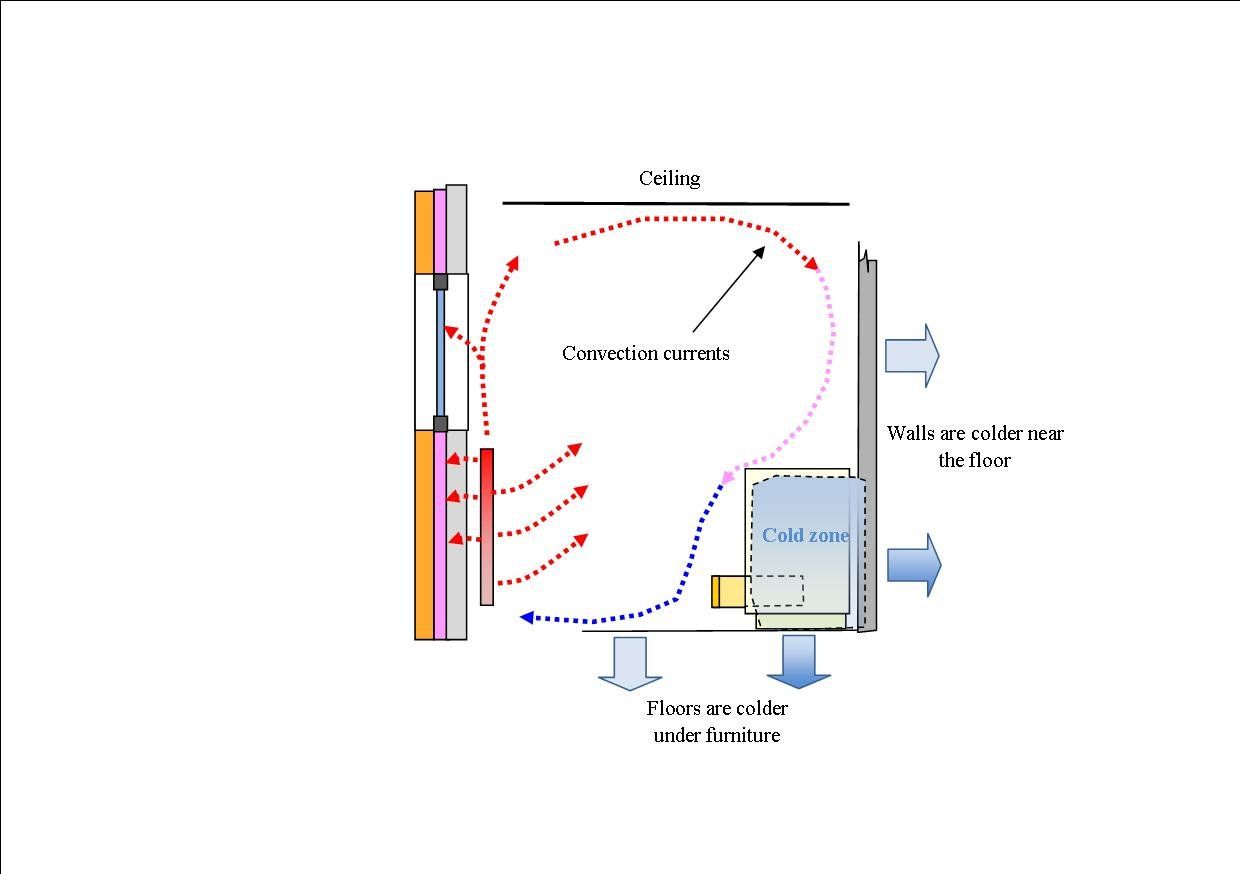Condensation & Mould around the Home
Condensation & Mould

The Blog this weeks is about: Condensation & Moulds
Now is the time that condensation and mould growth are most noticeable. The temperatures outside are dropping and rain and damp mornings are commonplace.
Here are:
· 6 easy ways to reduce Condensation and moulds around your home
And if you’re interested into the ‘whys and what ifs’ then the science will explain all.
The science behind as to:
· ‘Why does mould grow behind and under my furniture?’
· ‘Why have my best leather boots gone mouldy in a box under my bed?’
· ‘What if I turn the heating up?’
· ‘Why do my clothes get mould on them when they’re in a drawer?’
· ‘Why does the grout on my bathroom tiles go mouldy?’
To start with though:
6 easy ways to reduce Condensation and moulds
1.
Install
an efficient extractor in the bathroom over the shower area.
2. Turn the extractor on before you turn the shower or bath taps on.
3.
Ensure
there is a minimum gap of 10mm (3/8”) under the bathroom door. Make sure the gap is above the top of
the carpet pile.
4. Have the maximum over-run (30mins) set on the timer. Or leave the extractor on for 30minutes after you have finished the shower.
5. Wipe down the shower walls and shower tray or bath to remove as much water as you can.
6. Keep the bathroom / en-suite door closed or very slightly open to keep the humid air in that room. Stop it spreading throughout your home.
Those 6 easy steps will significantly reduce condensation in your home. Mould needs moisture to multiply and you’ve just reduced that.
The science for those interested:
Air is mainly nitrogen (78%) and oxygen (21%), plus 1% traces of other gases. That’s only a guide though.
Imagine nothing, absolutely nothing. No atoms, no gases, not a single thing – space – nothing.
Now imagine lots of tennis balls and table tennis balls in that space. They can represent the nitrogen and oxygen molecules. There is still space between them though where there is nothing. In that space there will be argon and carbon dioxide. They make up about 1% of the gas content of air.
Now we can put in some other gases into the spaces: Hydrogen and some more oxygen at the ratio of H2O or more commonly known as water. Water can be as a solid (ice), liquid (water) or gas (vapour). It is still H2O though.
Gravity acts on gases in the same way as it does on solids and liquids. The main difference is that the molecules in gases have energy that makes them continually move. They continually collide with other molecules bouncing around in the space.
When there are lots of molecules close together (more dense) the gravity has more effect.
Dry air has fewer molecules than humid air therefore lighter (at a comparable temperature).
Back to the shower – Hot water has put more energy into the molecules. They are moving around very quickly colliding frequently. Eventually unless more energy (heat in this case) is put in the molecules they will slow down and collide less.
The pressure will slowly decrease and more molecules will be in one place (density = mass divided by volume). The humid air will cool down and become even heavier as more molecules gather together.
End result; A hot shower will produce a lot of water vapour (it hasn’t got to be above 100°C though) The water vapour will go in between the nitrogen and the oxygen molecules until it virtually fills all the spaces. That is saturation point. If the air is at a specific temperature it can be calculated how much water vapour it can take up.
As the air cools down the molecules slow down and the collisions reduce. The number of molecules in the same volume increases and the air becomes denser. Cooler saturated air is heavier than warmer drier air. Therefore the humid air will go to as low as it can get – the floor.
Leave the bathroom door open wide and all that humid air will fall out of the room into other rooms, even down the stairs. As it does so the humid air will condense on anything that is cooler than the air. Cold surfaces like walls, windows, ceramic tiles, and carpets.
Furniture such as beds, settees, wardrobes and drawers will all be cooler than the humid air so will condense the moisture. Areas behind furniture are particularly vulnerable as there will be minimal heat (thermal convection). The gap will have a cool wall on one side and cool back of the furniture on the other.
The wall is likely to have plaster on it, or be made from a sheet of plasterboard. Gypsum plaster requires a lot of water to enable it to be fully workable. Literally hundreds of litres are required to plaster out a house. It then takes about a year for it to fully evaporate off if the room air is dry.
The plaster when dry is then full of minute holes that the water once filled. Crystals have formed with tiny gaps between them. The result is a hygroscopic material, meaning it will absorb moisture where available.
Now back to the plot.
Shower of hot water vapour saturating the air. The hot water is providing energy to the air molecules and they are all moving very fast and colliding. Gravity is trying to pull all the molecules downward therefore slowing them down. As they slow down more molecules gather in a specific volume of air and it sinks downwards.
Humid air contains more molecules than dry air therefore it is heavier and will sink.
Any material that is cooler than the humid air will condense the water vapour back into liquid form – water. If it is a non-porous material such as glass, metal or plastic it will form beads of water – condensation. If it is a porous material such as a carpet, bed linen, curtains, clothes then the condensation will soak into the material and it becomes damp.
Hygroscopic materials actually pull the moisture into them (a bit like kitchen towel soaks up spills). The walls and ceilings are plaster and most likely gypsum plaster and will pull in water vapour. Even if the surface has been painted over with a plastic emulsion the vapour can still go though. Water molecules are too big though so they cannot pass through.
So what have we ended up with? Hot and steamy air in the shower room. The air is cooling down and the high humidity air drops to the floor. The door is left open and all that humid air has a greater pressure than the cooler air of the other rooms.
The pressure enables the humid air to roll across the floor and down stairs if there are any (not very common in a bungalow though) filling anywhere it can. As it does so the water vapour condenses out of the air and either forms condensation (water) or makes things damp.
Enter the mould spore.
Air isn’t just nitrogen and oxygen plus a few trace gases. It also contains pollutants. They can be particulates (tiny particles of solid matter that are so small they cannot normally be seen). They are there though. That is what dust is. There is enough energy in air to bounce the gas molecules against the solids causing them to float. As the air cools down, less energy and the solid particulates are pulled downwards by gravity. (Dust settles more so at night when it is cooler and the air more static).
Moulds
Mould spores are microscopic, so tiny they are virtually invisible. They are naturally blowing around in the air. Natural and necessary they are one of nature’s cleaners taking anything they can back into the ground. A dead tree would still be there forever if it wasn’t for moulds and fungi.
The spores float in and out of everywhere including buildings and vehicles. We breathe them in and our bodies have various methods to stop them doing any damage to us. If we have a breathing issue though, or generally unwell the spores can set up reactions. They can cause eyes and ears to itch, throats to become inflamed, breathing difficulties and possibly worse.
Black spore mould is very common. The spores are present in the air as mentioned. If they become attached to a host surface they can soak up moisture and the chemicals it contains. They cannot eat as such but absorb moisture. If the moisture has carbon in it that is food to the spore and it will multiply. More moisture, more carbon = more spores until there is a colony of them.
Sugar is made up of carbon. Cellulose is the natural sugar found in wood and wood based products such as paper and cardboard. It is also a base for wallpaper paste hence; ‘Poly cell ’.
Plaster is hygroscopic and will soak up moisture from the air. The wall is a conductor of heat energy therefore the plaster will be continually cooled down. The plaster will condense water vapour and any wall paper will in turn become damp.
The mould spores can suck up (actually they can’t ‘suck’ they just absorb) the moisture including the carbon content in the cellulose. The wallpaper is a wood pulp product and the paste also full of cellulose.
Mould spores can then multiply very quickly. More steamy showers = more moisture everywhere = mould growth. The cooler areas behind curtains, behind furniture, in and under drawers, under mattresses and in wardrobes are all ideal for mould spores. The moist air will go everywhere.

Now turn the heating up. The air temperature in the room increases. The air is in contact with everything in the room. Some surfaces will heat up to the same temperature as the air. Other surfaces will try to warm up but due to various reasons (All explained in ‘Construction Science Explained’ published next year) they act as heat sinks.
Warm air is less dense than cool air. The air temperatures in a room will stratify with the warmest air at the top down to the coolest at the bottom. (Technically it is the least dense air at the top and the most dense at the bottom. Heat has an effect on density though). Heat sources such as radiators are generally near floor level so the hottest air will be above and around the radiator. That means the hottest air will then rise and push the top layer of warm air aside. That is known as convection currents.
‘Why does mould grow behind and under my furniture?’
Air that is behind furniture, under chairs and beds etc., in drawers and wardrobes will not receive any convection currents therefore remains much cooler. Humid air though rolls everywhere and will condense in those cooler areas.
Mould spores float everywhere. When they find a suitable host they start to multiply very quickly.
‘Why have my best leather boots gone mouldy in a box under my bed?’
That is why mould grows behind furniture, under chairs, settees and bed etc. Store your brand new leather boots you spent a fortune on under the bed. Only wear them on special occasions. Open the box that has been under the bed and ‘Oh Hell! There all covered in green mould and ruined!’
Floor level is as low as humid air can fall. Floors are normally colder than the rest of the room therefore the cardboard box will condense the vapour and absorb moisture. The humid air will enter the box as well. Leather and the linings are natural materials and contain carbon. They also contain fats. Black spore mould has a cousin that is blue/green.
It actually prefers fats and thrives on leather. So the moulds share the spoils with the black mould enjoying the cardboard and parts of certain lining materials. The cousin has a feast on the leather and really gets down into it. If there is any natural threads used for stitching then both moulds can absorb together.

‘Why do my clothes get mould on them when they’re in a drawer?’
The same is true for clothes in bottom drawers and in wardrobes. The clothes are kept away from the warm air so readily condense the vapour from the humid air and become damp.
Cotton contains carbon and the threads used to sew man-made fibres of plastic fabrics are commonly cotton. That is why clothes can allow moulds to grow on them. Bed linen; ‘poly cotton’, ‘flannelette’, Egyptian cotton are all food stores for mould.
‘Why does the grout on my bathroom tiles go mouldy?’
‘Why do I get mould on my grouting. That isn’t made of carbon is it?’
Most domestic use grouts are cement based. Cement is made from calcium carbonate (chalk) and that is the source of carbon. The grouting is micro porous and to a very small extent will absorb some of the moisture. Washing your hair with a conditioner, or using a body wash will add to the food that moulds can survive on. Conditioners in particular contain proteins.
Why do we shower? To wash body fats, sweat and bacterium off us and hopefully down the plug hole. However some remain on the wet tiles, shower curtains, shower tray or bath.
1.That was number 5. ‘ Wipe down the shower walls and shower tray or bath to remove as much water as you can’.
By wiping up as much of the condensation and aerosols as practical and squeezing them out down the plug hole the better.
The next Blog continues with Condensation and Moulds around the house.





